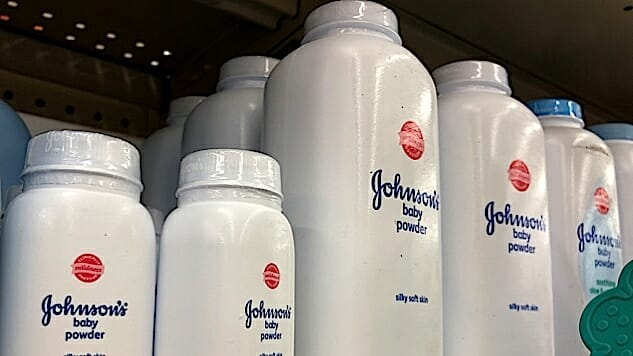The Joys of Capitalism, Part 483,323,323: Johnson & Johnson Knew Asbestos Was in Its Baby Powder, Did Nothing, People Died
Photo by Justin Sullivan/Getty Politics Features Johnson & Johnson
If some dyed-in-the-wool communist wrote this story as a work of anti-capitalist fiction, you would say it was too on the nose. It involves an evil company, a poisonous substance, death, sickness, and babies. As an argument against a corporate democracy, it’s just a little too good.
Alas, it’s real. Johnson & Johnson’s “raw talc and finished powders,” including its baby powder, contained asbestos from about 1971 to 2000, and they did everything in their power to hide it from both the public and regulators while taking a very, very long time to change anything.
We know this today in part because of Darlene Coker, who was dying of mesothelioma in 1997, had no idea why, and eventually concluded that it had something to do with the Johnson & Johnson Baby Powder she’d been using her whole life. She sued the company, they claimed it was “asbestos-free,” and because the burden of proof was on her, they didn’t have to turn over records or results—even after tests revealed that the mesothelioma was consistent with the fibrous asbestos often found in talc. Coker died in 2009.
Now, thanks to a Reuters special report, we know that J&J was lying. Per Reuters:
Two decades later, the material Coker and her lawyer sought is emerging as J&J has been compelled to share thousands of pages of company memos, internal reports and other confidential documents with lawyers for some of the 11,700 plaintiffs now claiming that the company’s talc caused their cancers — including thousands of women with ovarian cancer.
A Reuters examination of many of those documents, as well as deposition and trial testimony, shows that from at least 1971 to the early 2000s, the company’s raw talc and finished powders sometimes tested positive for small amounts of asbestos, and that company executives, mine managers, scientists, doctors and lawyers fretted over the problem and how to address it while failing to disclose it to regulators or the public.
Incredibly, while all this was happening, J&J also tried successfully to “influence U.S. regulators’ plans to limit asbestos in cosmetic talc products and scientific research on the health effects of talc.” In other words, at the same that they were hiding their own knowledge of asbestos in their products, they were trying to keep everyone else from even understanding the problem. These efforts took the place of, well, trying to actually fix it.
Over the years, the company repeatedly touted test results that showed no signs of absestos, while ignoring and suppressing the ones that did:
But J&J’s FDA submission left out University of Minnesota professor Thomas E. Hutchinson’s finding of chrysotile in a Shower to Shower sample – “incontrovertible asbestos,” as he described it in a lab note.
And:
J&J didn’t tell the FDA about a 1974 test by a professor at Dartmouth College in New Hampshire that turned up asbestos in talc from J&J – “fiberform” actinolite, as he put it. Nor did the company tell the FDA about a 1975 report from its longtime lab that found particles identified as “asbestos fibers” in five of 17 samples of talc from the chief source mine for Baby Powder. “Some of them seem rather high,” the private lab wrote in its cover letter.
They frequently tried to claim that these tests only applied to “industrial talc,” but then…oops:
Then, in 1992, three years after J&J sold its Vermont mines, the new owner, Cyprus Minerals, said in an internal report on “important environmental issues” in its talc reserves that there was “past tremolite” in the Hammondsville deposit. Hammondsville was the primary source of Baby Powder talc from 1966 until its shutdown in 1990.
Lawsuits against J&J have already begun to succeed, and one was recently affirmed by a judge who cited this withholding of evidence from the FDA:
“Providing the FDA favorable results showing no asbestos and withholding or failing to provide unfavorable results, which show asbestos, is a form of a misrepresentation by omission,” Middlesex County Superior Court Judge Ana Viscomi said in her June ruling.
The entire Reuters report has to be read to be believed, but in a nutshell, this is what happens when profit is king and loyalty to company over morality is rewarded. The good people leave, rationalizations are made, and a poisonous substance in a common household product remains, making thousands sick.
As of this writing, J&J’s stock price is down 11 percent, and based on the discovery of these company records, class action lawsuits are bound to pour in and succeed. It’s a punishment long delayed, and it won’t mean very much to the consumers who were lied to across the decades, and who became ill and died because they didn’t matter as much as money.